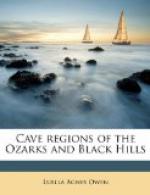“We have been deeper than the eighth tier but in narrow crevices barely admitting a man of average stature. In these the calcareous coating is much thicker than in any higher portions of the cave, but very little sign of box work is seen.
“Sometimes we make a comparison between the cave and a sponge. Take for instance a sponge as large as an apple barrel and there would be holes in it as big as a man’s thumb and closed hand. Now take a sponge, four miles square and five hundred feet deep with holes in proportion to the little sponge, and you have an illustration of The Wonderful Wind Cave, of Custer County, South Dakota.”
CHAPTER XI.
Wind cave continued.
PEARLY GATES AND BLUE GROTTO ROUTE.
A very much longer, more beautiful, and also more difficult journey than the one just described may be taken by those in whom the desire to see is greater than the fear of fatigue, or possibly, some little danger. With this object in view the Fair Grounds’ Route is followed through Monte Cristo’s Palace and into Milliner’s Avenue. Here we leave it by dropping off the bridge into a rough hole, which proves to be a passage descending into Castle Garden directly beneath the Avenue, and a room of considerable size, plentifully supplied with bowlders. Although interesting to visit, it has no points of such special merit as would seem to require a detailed account, the main importance attaching to it being the fact that it is the first portion of the eighth level visited. A little beyond, however, is something quite new. The floor is covered with a light yellow crust of calcite crystal, sufficiently strong to bear the weight of a limited number of guests without much fracture. It generally gives a hollow sound when struck, which is easily accounted for as there are small holes noticed by which steam evidently made its escape, and through these cavities can be seen but they are shallow. One place shows the crust broken up and with the edges of the pieces overlapped, like ice broken by a sudden rise of back-water, and in this position they have been firmly cemented.
This is where the slowly receding waters of the cave lingered in shallow pools above the small crevices long after the main portions had become dry. That the crust was formed on top of the water, instead of beneath its surface, has been proved by the only body of water now standing in the cave. This is called Silent Lake, and being situated on another route will be described in its proper place, but when discovered no water was visible nor its presence even suspected until the crust gave way under the weight of an explorer. The thin sheet of yellow calcite crystal thus broken was the same as that seen in great abundance in the now perfectly dry eighth level. The gradually decreasing volume of water has left




